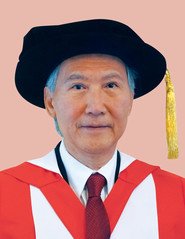
Mr. President,
Professor Hu Chenming is a practical visionary who has done more to advance the development and use of semiconductors than any individual over the past fifty years. Described as the father of 3-D transistors with his invention of Fin Field-effect transistor (FinFET) in 1999, Professor Hu’s accomplishments have been recognised and heralded by academics, inventors, investors, engineers, IT specialists, industry leaders, and politicians around the world. Throughout his career, Professor Hu has been a successful inventor, researcher, entrepreneur, industry executive, and award-winning teacher. When former president, Barak Obama, presented the National Medal of Technology and Innovation to Professor Hu in 2016, he was recognised for his “innovations in microelectronics including reliability technology, the first industry-standard model for circuit design, and the first 3-dimensional transistor, which radically advanced semiconductor technology.” In short, Professor Hu Chenming is a pioneer who loves challenges as much as he revels in the process of discovery.
Hu Chenming grew up in Taiwan and was, by all accounts, an extremely curious child. When, at age six, his father told him that a little man lived inside the alarm clock and was responsible for its ringing, Hu Chenming grew sceptical. To find out for himself, Hu disassembled the clock only to find gears, springs, and other moving mechanical parts. I don’t know if he reassembled the alarm clock, but something tells me that he probably did. Hu remained a curious child who excelled at school, entering National Taiwan University to study electrical engineering because he saw this subject as a challenge: it was the most competitive program to enter. As an undergraduate, Hu thrived and in 1968 he took a class from visiting professor Frank Fang, a semiconductor physicist, that helped steer Hu toward studying semiconductors.
As a graduate student beginning work at the University of California at Berkeley in 1969, Hu joined a team of researchers exploring metal oxide semiconductor transistors. During his first academic appointment at MIT, Hu devoted much of his early research into optical circuits, but following the 1973 Oil Shock, he gravitated toward developing low-cost solar cells. When he returned to Berkeley as a professor in 1976, he began research into hybrid cars that led him to reengage with semiconductors.
At Berkeley, with its close proximity to Silicon Valley, Professor Hu’s work took off, particularly after a rewarding sabbatical at National Semiconductor in 1982. His research team first developed what would become known as the Berkeley Reliability Tool (BERT) and the Berkeley Short Channel IGFET Model, which remain standard reliability measures for transistors to this day.
Professor Hu’s most important—landmark—discovery, occurred in 1999. Supported by a prestigious Defense Advanced Research Project Agency (DARPA) grant, Hu and his team of researchers developed a three-dimensional transistor. What did this mean to the real world? A lot. Hu’s transistor was so small, yet so powerful, that a single computer chip could contain 400 times more semiconductor transistors than ever before. The FinFET was heralded as a revolutionary advancement in technology when it was announced in November 1999, and it remains so to this day. “The secret to the success of the electronics industry,” Hu wrote, “has been built around making transistors ever smaller for the last three decades.” “But,” he added, “the laws of physics eventually will limit what can be done unless a new transistor design, is adopted.” Hu was responsible for just such a design.
Not surprisingly, the awards, the accolades, and the recognition of Hu’s achievements have been continuous since 1999. Along with his National Medal of Technology and Innovation, a few of the many awards Hu has received include: the Semiconductor Industry Association University Research Award in 2011; the Asian American Engineer of the Year award for lifetime achievements in 2011; the Institute of Electrical and Electronic Engineers (IEEE) Jun-ichi Nishizawa Medal for exceptional contributions in IC device scaling, modelling, and reliability in 2009; the IEEE Solid State Circuit Award in 2003; the IEEE Andy Grove Award in 1997; and the Defense Advanced Research Project Agency (DARPA) Most Outstanding Technical Accomplishment Award in 2000. Professor Hu Chenming has also been inducted into the US National Academy of Engineers (1997); Academia Sinica (2004); the Chinese Academy of Sciences (2007); and the World Academy of Sciences (2012).
Finally, in 2020, the Institute of Electrical and Electronic Engineers (IEEE) awarded Professor Hu Chenming with their Medal of Honor, the highest award they give to an individual “for a contribution that forms a clearly exceptional addition to the science and technology of concern to the IEEE.” In granting this award, the IEEE highlighted Professor Hu Chenming’s “distinguished career of developing and putting into practice semiconductor models, particularly 3-D device structures.” Indeed, over this distinguished career of achievements, Professor Hu has published over 900 articles, five books, secured 100 patents, and likewise been recognised as an outstanding, award winning teacher and postgraduate supervisor.
When asked what one piece of advice he would most like me to relay to our students, Professor Hu Chenming replied confidence: “Build your confidence.” Innovation, he stated, springs from creativity and a “big dose of confidence.” Through Professor Hu Chenming’s creativity and confidence, the world of electronics and the field of electrical engineering have become far more efficient, exciting, and indeed revolutionary.
Mr. President, it is my great honour and privilege to present to you, Professor Hu Chenming, for the award of Doctor of Science, honoris causa.
Citation written and delivered by Professor J. Charles Schencking, Public Orator, the University of Hong Kong




